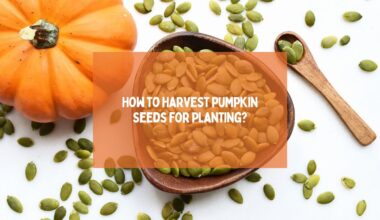Train pumpkin vines involve guiding them to grow in a specific direction to avoid overcrowding and promote fruit growth. This can be done by training the vines to grow straight out from the planting site and avoiding crossing the runners.
Secondary vines called runners can produce secondary roots if left to grow uninterrupted, so pruning them is recommended to promote growth to the fruit.
You can use string or wire to train vines. If space is limited, you can use a trellis to train vines to grow upward instead of on the ground. Culling pumpkins by cutting them off at the stem when they reach beach ball size can also promote better fruit growth.
This article helps you to train pumpkin vines to climb a trellis and also train jack o lantern pumpkin vines.
Let’s Start.
8 Steps To Train Pumpkin Vines

These steps include selecting the main stem, removing side shoots, supporting the main stem, training the vine to grow vertically, pinching off the growing tip, monitoring the plant for new growth, providing adequate water and sunlight, and harvesting the pumpkins when they are fully mature.
The steps are described below:
Related Reading
- Unveiling the Secrets of Perfect Pumpkin Soil For Growing Pumpkins
- Stages Of Growing Pumpkins
- White Pumpkins: A Guide to This Unique and Versatile Variety
- How to Grow Pumpkins in Pots?
1. Choose The Main Stem
To choose the main stem to train pumpkin vines, measure 10-15 feet from the center of the plant where it grows out of the ground. This is where you can trim the main vine if needed.
It is important to train the secondary vines to grow out and far from the main vine and the pumpkin fruit itself to prevent overcrowding and provide enough room for maintenance.
Secondary vines should be encouraged, but their growth should be managed by training them to grow out and away from the main vine and the fruit.It can help maximize the yield and quality of the pumpkins grown and ensure the plant grows in an organized and manageable manner.
2. Remove Side Shoots
To remove side shoots, cut secondary vines growing from the main vine with sharp pruning shears. Measure from the main vine and make the cut 10-12 feet (3-4 m) down the secondary line.
Cover the severed ends of the secondary vine with soil to prevent disease from entering the open wound and to reduce water loss. You can also cut the vine at the end and bury the end by placing a shovelful or two of soil over the cut end.
It is important to remove the “growth tip” or end of each vine, cutting it to where the last fruit was formed to promote better fruit growth.
3. Support The Main Stem

To support the main stems, you can train the secondary vines to grow out and far from the main vine and the pumpkin fruit itself to prevent overcrowding and provide enough room for maintenance. You can also bury the cut ends of the vine in the soil to protect from disease and retain moisture.
If the main vine is damaged, pumpkin plants are very resilient and can recover. It is important to cut the main vines after the fruit has developed enough to determine which fruit is the healthiest looking on the vine, then prune the vine to remove weaker pumpkins.
4. Train The Vine
To train the vine to train pumpkin vines, you can use a trellis to train vines to grow upward instead of the ground if space is limited. You can also train the secondary vines to grow out and far from the main vine and the pumpkin fruit itself to prevent overcrowding and provide enough room for maintenance.
It is important to manage the growth of the secondary vines and train them to grow out and away from the main vine and the fruit. You can also prune the tertiary vines to promote growth to the fruit. If you choose to trim the main stem, wait until it’s in the 10-15 foot length range and avoid pruning too much to prevent stunted growth.
5. Pinch Off The Growing Tip

To pinch off the growing tip, you will want to remove the “growth tip,” or end, of each vine, cutting it to where the last fruit was formed to promote better fruit growth. It is especially important to do this when vines are growing too long.
Additionally, you can train the secondary vines to grow out and away from the main vine and the pumpkin fruit itself to prevent overcrowding and provide enough room for maintenance.
You can also use a trellis to train vines to grow upward instead of toward the ground if space is limited. When pruning, cut off any vine that is longer than ten feet (3 meters) from the plant and snip off all of the small vines that shoot off from the secondary vines.
6. Monitor The Vine
To monitor the vine and train pumpkin vines, you should manage the growth of the secondary vines and train them to grow out and away from the main vine and the fruit. You can use string or wire to train vines to grow away from each plant and use a trellis to train vines to grow upward instead of toward the ground if space is limited.
You can also bury the vine by placing a shovelful or two of soil over the cut end to protect it from damage. You can use a small bamboo stake crisscrossed over the plant to keep it moving in the right direction.
You should ruthlessly prune vines if they grow longer than 10 feet (3 meters) from the plant and cut off any vine that is longer than ten feet (3 meters) from the plant.
7. Provide Adequate Water And Sunlight
To provide adequate water and sunlight to train pumpkin vines, you should give pumpkins at least 1 inch of water per week, watering deeply in the morning and on very hot afternoons, especially during fruit set.
It is best to use a soaker hose or drip irrigation to avoid wetting the leaves. Pumpkins require full sun, or at least six hours of light per day, to produce and mature their fruits.
You should select a full-sun spot to plant the seeds and space them out based on the recommendations provided on the packet. Additionally, you should avoid underwatering the plant and growing it close to other plants, as pumpkin plant vines can become overcrowded.
8. Harvest The Pumpkins
To harvest the pumpkins, you should let the main vine develop until the pumpkin fruit begins to emerge and cut these vines with your hand pruning shears about ten to fifteen feet beyond the last pumpkin fruit on the vine.
You should also train the secondary vines to grow out and away from the main vine and the pumpkin fruit itself to prevent overcrowding and provide enough room for maintenance.
Related Reading
- Golden Zucchini Squash: A Nutritious Summer Vegetable
- The Ultimate Guide To Growing Carrots In Your Garden
- 10 tasks to get a huge tomato harvest this spring
- What Is The Best Cucumber Plant Spacing For High Yields?
Conclusion
To train pumpkin vines, you should use string or wire to train vines to grow away from each plant and use a trellis to train vines to grow upward instead of toward the ground if space is limited.
You should train the secondary vines to grow out and away from the main vine and the pumpkin fruit itself to prevent overcrowding and provide enough room for maintenance. It is also important to take good care of the vine, provide adequate water and sunlight, and protect it from damage.
Finally, you should cut the main vine and bury the end by placing a shovelful or two of soil over the cut end to promote growth and prevent disease.
Thanks for reading!







